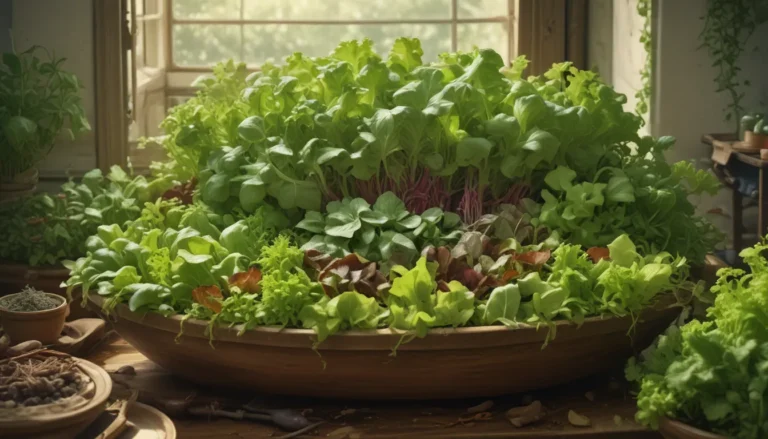Mastering Your Edible Herb Garden: Tips for Growing Abundance

Are you ready to dive into the world of edible herbs and discover the joys of growing your own flavorful additions to your meals? Edible herbs are not only rewarding to grow but also add beauty and fragrance to your garden. They attract essential pollinators and are excellent companion plants that help ward off pests.
In this comprehensive guide, we will explore everything you need to know to grow an abundant, edible herb garden that will bring fresh flavors to your kitchen. From selecting the right herbs to harvesting and preserving, we’ve got you covered.
What You’ll Learn
- Annuals and Perennials
- Selecting Herbs You Enjoy
- Direct Sowing
- Plant Propagation
- Sun and Shade Requirements
- Soil Preparation
- Location Considerations
- Watering Needs
- Fertilization Tips
- Container Care
- To Flower, or Not?
- Pruning Techniques
- Harvesting Methods
- Preserving Freshness
- Winter Care
- Spring Preparation
- Enjoying Your Bounty
If you are new to gardening or looking to expand your herb garden, this article will provide you with valuable insights to help you succeed.
Annuals and Perennials
Understanding the difference between annual and perennial herbs is vital when planning your garden. Perennials such as chives, lavender, oregano, sage, and thyme provide a stable foundation for your garden, requiring less replanting.
On the other hand, annuals like basil, cilantro, and summer savory need to be sown yearly. By selecting a mix of annuals and perennials, you can create a dynamic herb garden that continues to thrive year after year.
Select Ones You Enjoy
Cultivate herbs that align with your culinary preferences to maximize your enjoyment and utility. Whether you love Italian, Asian, or Mediterranean flavors, growing herbs like basil, rosemary, oregano, Thai basil, lemongrass, or coriander can elevate your dishes.
Having your favorite herbs within arm’s reach adds convenience and freshness to your cooking, enhancing the flavors of your meals.
Direct Sowing
Directly sowing annual herb seeds is not only cost-effective but also an enjoyable way to witness the growth progression. Planting seeds outdoors after the last frost or starting them indoors allows you to control the growing environment.
By staggering your plantings, you can ensure a continuous supply of fresh herbs throughout the growing season, extending your harvest well into fall.
Plant Propagation
Fall is an ideal time to propagate perennial herbs through root division or stem cuttings. By following proper propagation techniques, you can expand your herb garden without the need to purchase additional plants.
Selecting the right method for each herb type can result in successful propagation and healthy growth for future seasons.
Sun and Shade
Most herbs thrive in full sun, but some varieties, such as tarragon, prefer partial shade to thrive. Understanding the sunlight requirements of each herb ensures optimal growing conditions and healthy plants.
Consider the microclimates in your garden to provide the best possible environment for your herbs to flourish.
Soil Requirements
Herbs native to hot, dry regions like the Mediterranean thrive in lean, well-draining soil. Amending your soil with compost or sand can improve drainage and nutrient availability, creating an ideal growing environment for your herbs.
For heavy soils, raised beds or containers offer a viable alternative to ensure proper drainage and prevent root rot.
Location
Create microclimates in your garden to protect heat-loving perennials from harsh winter conditions. Choosing warm, sheltered spots can enhance the survival and growth of tender herbs during colder seasons.
Optimizing your garden layout to accommodate the specific needs of each herb variety can ensure their long-term health and productivity.
Watering Needs
Different herbs have varying water requirements, from drought-tolerant species like rosemary and thyme to moisture-loving plants like basil and mint. Understanding the watering needs of each herb helps prevent overwatering or underwatering, promoting healthy growth.
Grouping herbs with similar moisture requirements can simplify watering routines and support optimal plant health.
Fertilizers
Use fertilizers sparingly to avoid excessive growth at the expense of flavor and aroma. For in-ground plants, compost or manure amendments often provide sufficient nutrients for vigorous growth.
Container plants may require supplemental feeding with a balanced fertilizer to support their growth and productivity. Applying fertilizer judiciously ensures healthy plants and flavorful herbs.
Container Care
Growing herbs in containers offers flexibility and convenience, especially for small spaces. Providing well-draining soil, adequate sunlight, and regular watering can help container herbs thrive.
Applying best practices for container gardening, such as proper drainage and feeding, maintains the health and vitality of your herbs throughout the growing season.
To Flower, or Not?
Deciding whether to allow your herbs to flower depends on their culinary and aesthetic value. While flowering herbs like lavender and rosemary offer beauty and attract pollinators, leafy herbs like basil and parsley may lose flavor when allowed to flower.
Pruning or pinching back flowering stems can prolong the leafy growth of herbs and preserve their flavors for culinary use. Selectively allowing herbs to flower for seed collection or pollinator attraction adds diversity to your garden.
Pruning
Pruning herbs at the right time, typically in late winter or early spring, promotes new growth and maintains plant vigor. Using proper pruning techniques, such as cutting back one-third of the plant or removing dead branches, can rejuvenate leggy or overgrown herbs.
Regular pruning encourages bushy growth and enhances the overall appearance of herb plants, supporting their long-term health and productivity.
Harvesting
Harvesting herbs in the morning when essential oils are most concentrated ensures the fullest flavor and aroma. Selecting younger leaves and flower heads for harvest preserves the quality and intensity of their flavors.
Choosing the right timing and techniques for harvesting flowers, leaves, and seeds can maximize the culinary and aromatic benefits of your herbs throughout the growing season.
Preserving
Preserving herbs through drying or freezing extends their shelf life and allows you to enjoy fresh flavors year-round. Air drying leafy herbs or freezing them in ice cubes are effective methods for preserving the flavors and aromas of your herbs.
By following proper techniques for drying and freezing herbs, you can maintain their quality and use them in various culinary applications.
Winter Care
Prepare your herbs for the winter by cleaning up plant debris and mulching perennials to protect them from freezing temperatures. Providing adequate insulation and shelter for your herbs can improve their winter survival and enhance their vigor in the following growing season.
Adapting your winter care practices to the specific needs of each herb variety ensures their long-term health and resilience.
Spring Prep
Spring preparation involves cleaning up garden beds, topdressing with compost, and pruning to encourage new growth. Removing dead or damaged stems and preparing the soil for planting sets the stage for a successful growing season.
By addressing the specific requirements of your herbs in the spring, you can promote healthy growth and abundant harvests throughout the year.
Enjoying Your Bounty
From fragrant flowers to aromatic leaves, edible herbs offer a wealth of benefits for gardeners and cooks alike. Embrace the beauty and functionality of herb gardening by incorporating diverse varieties in your garden and kitchen.
Discover the joys of growing your favorite herbs and savoring their fresh flavors in your culinary creations. Whether you’re a seasoned gardener or a novice, edible herbs provide a rewarding and enriching experience that enhances your connection to nature and nourishes your body and soul.
Experiment with different herbs, harvesting techniques, and preservation methods to fully enjoy the bounty of your herb garden. Share your tips and experiences with growing edible herbs in the comments below to inspire fellow gardeners and cooking enthusiasts.
Mastering the art of growing edible herbs requires patience, dedication, and a love for nature’s gifts. By following these tips and guidelines, you can cultivate a bountiful herb garden that delights your senses and enhances your culinary creations.
Happy gardening, and may your herb garden flourish with abundance and flavor!





